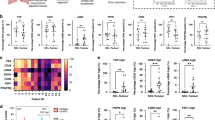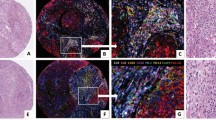Abstract
Angiogenesis is recognized as an important step in tumour pathogenesis that is related to invasion and metastatic spread and which consequently results in poor clinical outcome. In this study, we have examined the role of tumour stroma-activated fibroblasts and macrophage infiltration in the development of the angiogenic and metastatic phenotype in non-small-cell lung cancer (NSCLC). A total of 141 cases of early stage I-II NSCLC treated with surgery alone were analysed. The JC-70 (anti-CD31) MAb was used for the assessment of vascular grade. The P-GF.44C MAb was used to assess thymidine phosphorylase (TP) reactivity in cancer cells, stromal fibroblasts and macrophages. Cancer cell TP overexpression related to high vascular grade and to advanced T stage (P = 0.0004 and P = 0.02). Expression of TP in stromal fibroblasts also correlated with high angiogenesis (P = 0.01), but was independent of cancer cell expression. Fibroblast TP overexpression was related to abundant stroma (P = 0.003), suggesting that TP may be a marker of active stroma. Moreover, intense macrophage infiltration was associated with fibroblast TP reactivity, regardless of the amount of stroma, suggesting that macrophages may be a major contributor to TP expression in stroma. Survival analysis showed that cancer cell TP overexpression was related to poor prognosis (P = 0.005). Although stroma TP is related to angiogenesis, in the low vascular grade group it defined a group of patients with better prognosis (P = 0.02). It may be that fibroblast TP reactivity is an indirect marker of tumour infiltration by functional macrophages, which have an antitumour effect. We conclude that stromal macrophage and fibroblast TP reactivity may have an important role in non-small-cell lung cancer behaviour. Understanding the role of stromal fibroblasts and inflammatory cells and their interaction with oncoprotein expression is essential for the elucidation of lung cancer pathogenesis.
This is a preview of subscription content, access via your institution
Access options
Subscribe to this journal
Receive 24 print issues and online access
$259.00 per year
only $10.79 per issue
Buy this article
- Purchase on Springer Link
- Instant access to full article PDF
Prices may be subject to local taxes which are calculated during checkout
Similar content being viewed by others
Author information
Authors and Affiliations
Rights and permissions
About this article
Cite this article
Koukourakis, M., Giatromanolaki, A., Kakolyris, S. et al. Different patterns of stromal and cancer cell thymidine phosphorylase reactivity in non-small-cell lung cancer: impact on tumour neoangiogenesis and survival. Br J Cancer 77, 1696–1703 (1998). https://doi.org/10.1038/bjc.1998.280
Issue Date:
DOI: https://doi.org/10.1038/bjc.1998.280
This article is cited by
-
The FBW7-MCL-1 axis is key in M1 and M2 macrophage-related colon cancer cell progression: validating the immunotherapeutic value of targeting PI3Kγ
Experimental & Molecular Medicine (2020)
-
Macrophage expression of tartrate-resistant acid phosphatase as a prognostic indicator in colon cancer
Histochemistry and Cell Biology (2014)
-
Immune responses and immunotherapeutic interventions in malignant pleural mesothelioma
Cancer Immunology, Immunotherapy (2011)
-
Inflammatory cell infiltration of tumors: Jekyll or Hyde
Cancer and Metastasis Reviews (2007)
-
Modulation of thymidine phosphorylase by neoadjuvant chemotherapy in primary breast cancer
British Journal of Cancer (2004)



